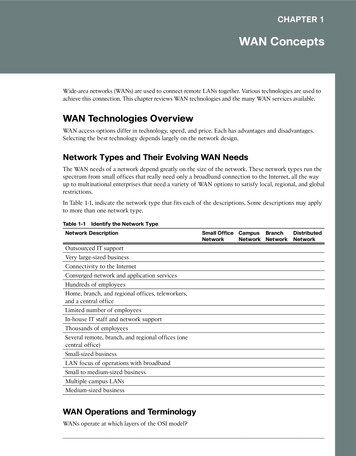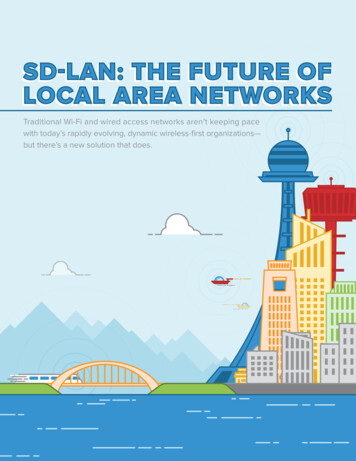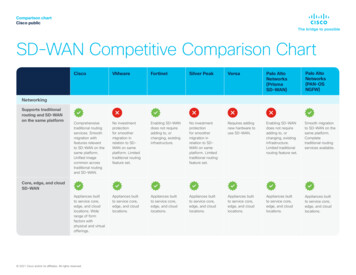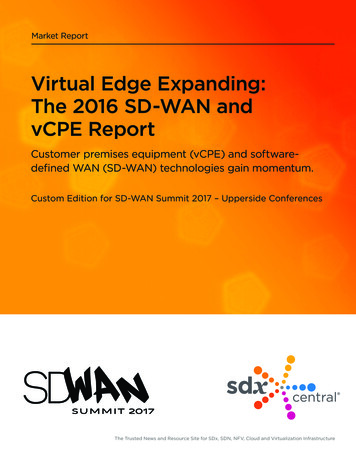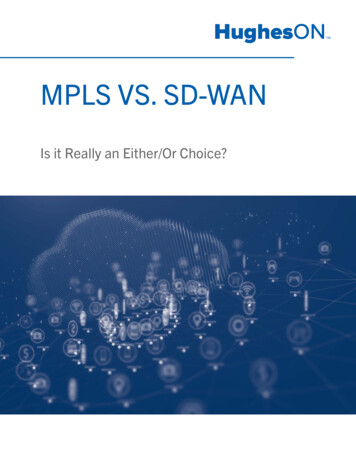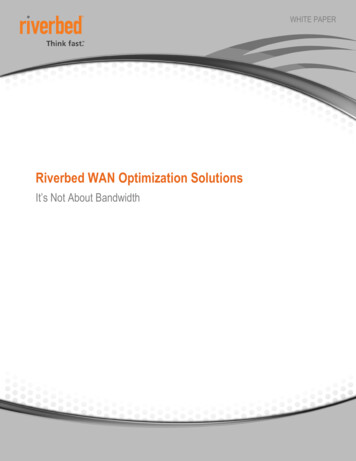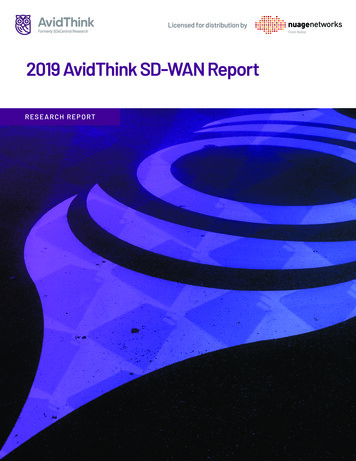
Transcription
Licensed for distribution by2019 AvidThink SD-WAN ReportRE S E A R C H R EP ORT
2019 AvidThink SD-WAN ReportTable of ContentsIntroduction . . . . . . . . . . . . . . . . . . . . . . . . . . . . . . . . . . . . . . . . . . . . . . . . . . . . . . . . . . . . . . 1SD-WAN PrimerWhat is SD-WAN? . . . . . . . . . . . . . . . . . . . . . . . . . . . . . . . . . . . . . . . . . . . . . . . . . . . . . . . . . . 2Adopting SD-WAN . . . . . . . . . . . . . . . . . . . . . . . . . . . . . . . . . . . . . . . . . . . . . . . . . . . . . . . . . . 3Who Can Benefit from SD-WAN? . . . . . . . . . . . . . . . . . . . . . . . . . . . . . . . . . . . . . . . . . . . . . . . . . 5Key SD-WAN Capabilities . . . . . . . . . . . . . . . . . . . . . . . . . . . . . . . . . . . . . . . . . . . . . . . . . . . . . 7SD-WAN Vendors and their Roots . . . . . . . . . . . . . . . . . . . . . . . . . . . . . . . . . . . . . . . . . . . . . . . .10SD-WAN Market AnalysisSizing the SD-WAN Market . . . . . . . . . . . . . . . . . . . . . . . . . . . . . . . . . . . . . . . . . . . . . . . . . . . . 12Ongoing Barriers to SD-WAN Adoption . . . . . . . . . . . . . . . . . . . . . . . . . . . . . . . . . . . . . . . . . . . . .12SD-WAN Market Update — Key Changes Since Our Last Update . . . . . . . . . . . . . . . . . . . . . . . . . . . . . 13Key SD-WAN Topics in 2019 . . . . . . . . . . . . . . . . . . . . . . . . . . . . . . . . . . . . . . . . . . . . . . . . . . . . 17Conclusion — SD-WAN Continues Ramping in 2019 . . . . . . . . . . . . . . . . . . . . . . . . . . . . . . . . . . . .19Research Reports are independent content created by analysts working for AvidThink LLC. These reports are madepossible through the sponsorship of our commercial supporters. Sponsors do not have any editorial control over thereport content, and the views represented herein are solely those of AvidThink LLC. For more information about reportsponsorships, please reach out to us at research@avidthink.com.About AvidThink AvidThink is a research and analysis firm focused on providing cutting edge insights into the latest in infrastructuretechnologies. Formerly SDxCentral’s research group, AvidThink launched as an independent company in October 2018.Over the last five years, over 110,000 copies of AvidThink’s research reports (under the SDxCentral brand) have beendownloaded by 40,000 technology buyers and industry thought leaders. AvidThink’s expertise covers Edge and IoT,SD-WAN, cloud and containers, SDN, NFV, hyper-convergence and infrastructure applications for AI/ML and security.Visit AvidThink at www.avidthink.com. Copyright 2019 AvidThink LLC, All Rights ReservedPage ii
RE S E A R C H R E P ORT2019 AvidThink SD-WAN ReportIntroduction — New Year, New ChallengesSoftware-Defined Wide Area Networking (SD-WAN) is undoubtedly one of the hottest IT trends today. It’s rare that atechnology can generate as much interest across both enterprise and service provider markets. For enterprises, SD-WANrepresents an opportunity to upgrade legacy WANs, increasing bandwidth and resiliency without breaking the bank. AndSD-WAN for service providers is the next wave of value-add services, one that potentially helps save them from being justcommoditized bandwidth providers.The beginning of 2019 has seen most of the industry buzz shift from the original network functions virtualization (NFV)movement with vCPEs, to a decidedly enterprise-centric SD-WAN market. IN fact, most of the market interest today is drivenby corporations looking for a better solution to their existing WAN deployments.Whether it’s enterprise IT trying upgrade their WAN, communications service providers (CSP) enhancing basic connectivitywith value-added services, or managed service providers (MSP) rolling out new managed WAN services, network users aretired of complicated, proprietary networks that require complicated configurations. In this report, we’ll explain how the edgeis being upgraded with SDN technology that is more intelligent and agile than past proprietary customer premises equipment(CPE).AvidThink (formerly SDxCentral Research), has spent the last few years covering SD-WAN and the related virtual CPE (vCPE)market. To gather material for our industry reports, we spend time talking to CSPs, MSPs, enterprise end users, technologyvendors, and other community members.The goal of this updated report is to educate enterprises and service providers on the overall market and assist in theselection of the appropriate vendor and managed SD-WAN offerings. The report is split into two sections. The first sectionprovides a primer on SD-WAN for readers who might still be coming up to speed on the technology. It also serves as a quickrefresher for those who want a more current overview of SD-WAN. The second section provides an update on key events in theSD-WAN market and our analysis of the trends.We hope you find this report useful. As always, the AvidThink research team welcomes feedback on our work. We can bereached at research@avidthink.com. Copyright 2019 AvidThink LLC, All Rights ReservedPage 1
2019 AvidThink SD-WAN Report SD-WAN Primer2019 AvidThink SD-WAN ReportSD-WAN PrimerWhat is SD-WAN?With all the hype around SD-WAN, one would think that the term would have been well-defined by now, unfortunately, that’snot the case. Just about every vendor with a WAN-related offering has pushed their own definition of SD-WAN into themarketplace. In 2019, SD-WAN has come to mean any enterprise-edge WAN connectivity solution with a centralized controllerthat manages multiple edge locations.Regardless, let’s start with some basic terms in the SD-WAN taxonomy, so that we’re all on the same page.SD-WAN, uCPE, vCPE Terminology and TaxonomyThe term SD-WAN started at the enterprise edge. However, there’s a related set of platforms and technologies that CSPs arealso rolling out to both consumer and business wireline services. As we will see later, there are two main ways of consumingSD-WAN. One is the do-it-yourself (DIY) approach where enterprises take on the full installation, deployment, configuration,and ongoing management of CPE devices in remote offices, running the SD-WAN solution on their own. The other is toconsume SD-WAN as a managed offering, where a third-party —either a networking vendor, MSP or CSP — handles all thecomplexities of the service, from deployment to ongoing management. Sometimes, these managed SD-WAN services provideenterprises with simple self-service portals that cover everything from configuring add-on services, such as security androuting, to purchasing new CPEs and provisioning new locations.In both types of consumption model, the terminology and taxonomy will be similar, so let’s start with some of the commonlyused terms: SDN: Software-defined networking (SDN) is a movement that began in the early 2010s. It advocated the separation ofthe control plane of network devices from the data plane, allowing a centralized approach for networking control thatprovided simplification and potential global optimization for the routing and switching of network packets. SDN alsoadvocated open APIs and a programmatic approach to networking. The principles of SDN are embedded in just aboutevery SD-WAN solution in the market. NFV: Network functions virtualization is an approach first put forth by a set of leading global CSPs that pushed for theuse of virtualization to replace proprietary networking equipment in the carrier core. The premise was that the use ofstandard commoditized data center servers coupled with the use of virtual machine (VM) technology would result inincreased flexibility and agility as well as reduce overall CapEx and OpEx. vCPE: vCPE technology is used to allow proprietary hardware and software to be replaced with virtualized instantiationsthat may run at customer premises — sometimes on lower cost equipment, in central offices (CO) or points of presence(POP), or in data centers. Many vCPE architectures provide hybrid approaches that allow different functions to run indifferent locations to optimize for latency, manageability, and cost. uCPE: The uCPE or universal CPE is essentially a white box, open hardware, platform that replaces the proprietary WANappliances of today. Most often based on x86 or ARM platforms, it is a low-cost general purpose appliance that can runsoftware VNF functions, replacing one or more proprietary boxes that play a role in traditional WANs. VNFs: Virtual Network Functions are the virtual embodiment of the physical network functions translated into an NFVdeployment. Depending on how a vendor or CSP views the solution, SD-WAN might be treated as a VNF running on auCPE with other network layer 4-7 VNFs. Another model is to treat SD-WAN as the base platform that can host otherVNFs for more advanced capabilities. SD-WAN: SD-WAN is now typically used as an umbrella term that extends beyond the virtual CPE and into the core of theWAN or service-provider network. It enables service providers and enterprises to leverage existing physical CPE orvCPE technology to create fully managed multisite networks, which may integrate links using the internet and private Copyright 2019 AvidThink LLC, All Rights ReservedPage 2
2019 AvidThink SD-WAN Report SD-WAN Primernetworks. Typically, SD-WAN architectures reflect disaggregation of the control and data plane and improved flexibilityand programmability common across SDN solutions. NaaS: Network-as-a-Service (NaaS) is essentially a managed services offering that frees an enterprise up from dealingwith the complexities of managing routers, firewalls, and even WAN provisioning. Some enterprises view managedSD-WAN as a class of NaaS offering while others view SD-WAN as a potential addition on top of a NaaS solution. Withinthe context of SD-WAN, we’ll discuss some of the vendors, like Cato and Aryaka, that align well with the NaaS plusSD-WAN classification.As a point of clarification, SD-WAN is usually used in the context of enterprise WAN edge solutions. There is a correspondingvCPE solution that can serve residential broadband deployment as well. However, the industry typically terms those simply asvCPE solutions and does not usually lump them in under the SD-WAN umbrella.Adopting SD-WANBusinesses today are facing the need to transform themselves to provide more agility in dealing with customer and partnerneeds. It’s been made clear that businesses who can adapt to the new digital economy will survive and thrive, like Amazon, andthose that don’t, like Sears, will not. With a looming recession, businesses are scrambling to ensure their IT platforms are bothcost-effective and agile, while providing the necessary capacity and features to drive employee productivity.The WAN edge has not received much attention in the past decade, and IT organizations are under pressure to improve WANsecurity, performance, and reliability. At the same time, WAN needs to be agile to respond to rapid business changes.In addition, digitally transformed businesses are increasingly distributed with critical business operations in remote offices,home offices, and partner locations. And with the move to both public and private clouds, any WAN solution needs toaccommodate not just the edge, but the clouds as well.SD-WAN is a solution that can increase the bandwidth to remote siteswhile ensuring greater reliability. And a solution that can achieve thiswithout increasing costs or overburdening IT staff. The ability of SD-WANto take advantage of low-cost direct internet access links whilemaximizing use of existing private multiprotocol label switching (MPLS)networks makes it a favorite with enterprise IT. Plus the added benefits ofcentralized control and zero-touch deployment helps CIOs reduce costswhile increasing compliance and security.There are several options for bringing SD-WAN into an enterprise:With a looming recession,businesses are scrambling toensure their IT platforms areboth cost-effective and agile,while providing the necessarycapacity and features to driveemployee productivity. Keep an existing CPE and install new software, for example,loading Cisco Viptela on existing Cisco ISR appliances. Keep an existing platform and put a separate device behind an existing router and run an overlay without impactingexisting underlying connectivity. Replace existing edge devices with new uCPEs or SD-WAN appliances, often consolidating a few different legacyappliances.Certainly, making a clean break and installing a new uCPE or SD-WAN appliance would reduce the complexity of ongoingmaintenance. But the different options will fit different enterprise needs in terms of compatibility with existing brownfieldinstallations, downtime risks, and overall costs. Copyright 2019 AvidThink LLC, All Rights ReservedPage 3
2019 AvidThink SD-WAN Report SD-WAN PrimerManaged SD-WAN vs DIYRelated to the question of adopting of SD-WAN is the choice between DIY or managed. Many enterprises today, aside from thelargest multinationals with unique needs, are going the managed SD-WAN route. These enterprises are either purchasingSD-WAN offered by their existing connectivity provider, or from an MSP, or purchasing a NaaS offering with SD-WAN from avendor.The advantages of managed SD-WAN include: No need to hire specialized staff with deep network expertise to design, evaluate, and operate an enterprise SD-WAN. A reduction in vendor management overhead, since the managed provider will usually manage both connectivity circuitsas well as the SD-WAN feature service. A single ‘neck to choke’ and a single number to call if there’s an issue. The managed provider is responsible for the wholeservice: from the circuit to the SD-WAN feature-set. This also helps with ensuring that any overall service-levelagreement (SLA) will be monitored and maintained at the SD-WAN level.However, enterprises that choose to go the DIY route have: More control over SD-WAN configurations and deployment options. For instance, picking different SD-WAN connectivityoptions in different markets. Flexibility to potentially run more than one SD-WAN vendor in different geographies if needed. Ability to choose the most appropriate SD-WAN vendor for themselves. Potential cost-savings from scale economies if they have enough sites and can amortize their IT spend accordingly.For those organizations who don’t have, or shouldn’t have, the necessary expertise to select, install and deploy, configure, andmaintain a complex SD-WAN solution across disparate locations, the managed offering is a godsend. As such many SMBs willgo the managed route. Even enterprises with the necessary expertise in-house, might opt for a managed SD-WAN offeringbecause there’s an opportunity cost with using these valuable resources on SD-WAN when there are other high-value items toservice.Where to Adopt SD-WAN — Locations and VerticalsSo where do SD-WANs fit best? We’ll take a look at this in terms of two axes: location of deployment and select marketverticals. Let’s start with locations.Remote Offices and Branch sitesThese sites include sales and support offices, retail and hospitality locations, or medical clinics that often lack on-site IT staff.Many of these sites cannot be easily serviced with MPLS circuits and such service is often prohibitively expensive whenavailable. SD-WAN using business broadband, DSL and 4G/LTE can deliver MPLS-like performance, reliability, and security ata much lower cost. The ability of SD-WAN to be pre-configured and remotely administered is especially important since manyorganizations have consolidated IT infrastructure down to a handful of internal data centers or use centrally managed publiccloud services. This means remote sites are reliant on WAN as their lifeline to enterprise applications and data. When the WANgoes down, business stops, thus, the inherent high-availability of redundant SD-WAN circuits is critical to maintaining remoteoperations.Remote Work SitesAll remote work sites like construction, resource extraction — mining, oil and gas, media — TV, movies, advertising,ocean-going cargo and passenger ships, and natural disaster response must be tethered to central IT operations forcommunications, enterprise applications, and data. Many of these are in extremely remote locations far from the nearest fiber Copyright 2019 AvidThink LLC, All Rights ReservedPage 4
2019 AvidThink SD-WAN Report SD-WAN Primeror coax connection and must be served by terrestrial or satellite wireless circuits. In these situations, SD-WAN is the onlyoption for providing enterprise-class networking.Business PartnersContract manufacturers, call centers, and professional services providers are frequently a continent away in areas withoutmany data providers. Connections often must terminate at facilities in underdeveloped countries with few WAN options andwhere procuring conventional MPLS or private T-carrier circuits is both prohibitively expensive and painfully slow. As withremote worksites, SD-WAN can provide a virtual private circuit over consumer-grade broadband and bypass entrenched,regulated local telcos. Using SD-WAN via a NaaS provider is particularly beneficial in these situations since many have dozensof regional POPs and can often terminate a local broadband link in country, before routing the traffic over the provider’shigh-speed global private network.SD-WANs will normally provideencrypted site-to-site access asVPN devices do, but the promiseof a centralized access andnetworking policy that stretchesfrom the data center to the edgeis appealing to enterprises.Regardless of the location, many organizations prefer SD-WAN evenin situations where conventional circuits are widely available andalready deployed because they want better WAN telemetry. Themonitoring detail over aggregate usage, individual circuit traffic,path availability and performance provided by most SD-WANproducts and services are a compelling feature for organizationsthat sometimes see conventional, carrier-provided WAN circuits as ablack box.Private Clouds and Data centersIn addition to remote sites for SD-WAN, we are seeing the use ofSD-WAN within private clouds and data centers. Where solutionspreviously entitled the use of firewall/VPN devices or software VPNsfor connectivity, enterprises are now contemplating the use of virtual or physical SD-WAN instances within private datacenters. SD-WANs will normally provide encrypted site-to-site access as VPN devices do, but the promise of a centralizedaccess and networking policy that stretches from the data center to the edge is appealing to enterprises — especially those inregular industries, who can benefit from the consistency and compliance.Public Clouds and Virtual Private Clouds (VPCs)Just like private data centers, enterprises increasingly need connectivity into public clouds. Enterprises are running a goodportion of their application infrastructures within public cloud VPCs like Amazon Web Services (AWS), Microsoft Azure, andGoogle Cloud Platform (GCP). While VPCs typically provide gateways for external connectivity, and while FW/VPN virtualdevices are an existing alternative, SD-WANs provide another option. The advantages of using SD-WAN are similar to those ofprivate clouds, with the potential added benefit of WAN optimization — for SD-WAN solutions that provide it — resulting inimproved application performance.Who Can Benefit from SD-WAN?The benefits of SD-WAN will be felt by all market verticals. For instance, the improved reliability —through use of multiplelinks, increased bandwidth while keeping costs down — through use of direct internet access links, plus all the reduction inmanagement overhead benefits will accrue to businesses both big and small.Looking at real-world deployments, we see that VMware-Velocloud — now VMWare NSX SD-WAN — has customers likeBayclub, STAR financial bank, All-tile CCS, and Café Rio among others. While Cisco-Viptela calls out First American, GAP, andFifth Third bank. SD-WAN vendor, SimpleWAN, boasts of names like Domino’s Pizza, Meineke, Supershuttle, and FarmersInsurance. India-based Lavelle Networks counts commerce giant Flipkart as one of its top customers. Flipkart wassuccessful because it grew up in the cloud world, getting to huge scale with little investment in traditional data centers, andyet SD-WAN adds value to them in cloud connectivity. An example supporting the importance of cloud connectivity is Nuage Copyright 2019 AvidThink LLC, All Rights ReservedPage 5
2019 AvidThink SD-WAN Report SD-WAN PrimerNetworks’ recent win with SciSports, a cloud-based analytics company. SciSports uses Nuage’s technology to provide anoverlay on top of redundant high-speed internet links, straight into Google’s Cloud Platform for real-time analysis.With so many different examples, we’ll pick a couple of market verticals to highlight and explain how SD-WAN can add valuegiven their unique requirements.Retail StoresRetail stores’ needs center around compliance and scalability, including the payment card initiative (PCI) to protect customers’credit card information. Encryption of traffic and network segmentation to ensure credit-card-information-carryingnetworks are restricted and protected is paramount. Added features including malware and breach detection, often found insecurity-centric SD-WAN solutions, can help retailers avoid or mitigate embarrassing and damaging leaks of customerinformation.The seasonality of retail and the rise of popular pop-up retail establishments within unconventional physical locations canalso benefit. SD-WAN’s ability to leverage direct internet access and 4G LTE backhaul options can provide the quickprovisioning needed in unexpected locations.QoS and application prioritization can also help ensure that retail applications and credit card traffic get on the fast lane,reducing wait times and improving customer experience. Similarly, tracking or customer interaction information can be givenappropriate priority to ensure that real-time analytics for omni-channel optimization remains real-time.HealthcareAs another regulated industry, healthcare could see great benefits from SD-WAN too. Healthcare is becoming increasinglydistributed to facilitate proximity to patients and improve overall access. SD-WAN can provide value with large data transfersets for electronic health records and diagnostic imaging as well as protecting key patient information and ensuring HealthInsurance Portability and Accountability Act (HIPAA) compliance through encryption and segmentation.In addition, healthcare’s use of more Internet of Things (IoT) medical devices, including smart monitors, adds to the bandwidthdemands on both the LAN and the WAN. The same networks also carrybusiness-critical traffic for patient scheduling, payments, and other keyfunctions.SD-WANs that provide sophisticated policies for segmentation can addsignificant value here, as can SD-WANs with visibility and securityanalytics to help detect breaches and potential extraction of sensitivepatient data.In the future, as we move to telemedicine, where remote surgery or remotediagnostics become part of the overall healthcare offering, the security,reliability, and quality of connection that SD-WAN platforms can providewill be critical to the success of these initiatives.SD-WAN’s ability to leveragedirect internet access and4G LTE backhaul optionscan provide the quickprovisioning needed inunexpected locations.Financial ServicesFinancial services organizations like banks and brokerages continue to engage at their retail locations and local branches toserve their customers while simultaneously building their online engagement model. These branches are measured bycustomer growth, balances, and churn. They are seldom equipped with tech savvy personnel yet require reliable, securecommunications with central data centers as well as the cloud. Traditional users of leased line and MPLS, they are nowmigrating to using SD-WAN to improve security, reliability, and performance and cost. Improved bandwidth management cantranslate into an overall better quality of experience for their customers. At the same time, SD-WAN provides for improvedsecurity with fine-grained policy and segmentation rules. These rules can be used to segregate different lines of businesses,ensuring compliance and privacy. Copyright 2019 AvidThink LLC, All Rights ReservedPage 6
2019 AvidThink SD-WAN Report SD-WAN PrimerSimilarly, insurance companies have many and varied locations with a need to ensure security across local offices with adiversity of connectivity types. SD-WAN’s ability to use direct internet access with 4G LTE backup allows new agent andbroker locations to be set up faster with more reliability than traditional solutions.ManufacturingMost manufacturing organizations have been transforming themselves from independently controlled and managedoperational systems to more centrally managed and controlled networks that tie back to centralized data centers. With therapid advancement of IoT, more sensors, data, and control will become the norm. This requires network segmentation toisolate specific production lines, facilities, or regions, and a secure, reliable, scalable, and cost-effective connection back tothe central command and the cloud — all capabilities that SD-WAN can provide.Key SD-WAN CapabilitiesSD-WANs are now converging in terms of their capabilities. As we will describe later, many SD-WAN vendors came fromadjacent markets of firewall, routing, and WAN optimization, which helps define their initial platform strengths. However,regardless of their legacies, we see SD-WAN platforms aiming for a common set of features. These capabilities will include:CategoryDescriptionBasic SD-WANFundamental capabilities like centralized cloud management and multilink handlingPlatformZero-touch provisioning (ZTP), trusted platform, and diverse connectivity typesRoutingSupport for static routing as well as routing protocols including BGP and OSPFSecurityCentralized access policies, stateful firewall, next-gen firewall, and breach detectionQoS and WAN optimizationApplication-specific improvements for common enterprise applications, TCP andHTTP/S optimization, forward-error correction, and advanced QoSBranch extensionLAN and access control plus wireless integrationCloud integrationLocal cloud breakout and fast on-ramp to popular SaaS and IaaS platformsAdvanced SD-WANVNF chaining and programmatic accessMSP featuresMulti-tenancy and other MSP-relevant capabilitiesBasic SD-WANSoftware control plane with physical circuit agnosticism by laying a virtual network over any type and combination of WANcircuit, whether traditional MPLS, carrier Ethernet, cable, or DSL broadband or wireless LTE.Central management and cloud-based control of all WAN paths in an enterprise using a single admin console that setsconfigurations and policies for each virtual circuit. The SD-WAN controller also logs performance metrics and errorconditions that can be summarized in reports, used to trigger alerts, and forwarded to other IT functions like trouble ticketingsystems. Performance measures include things like aggregate performance for virtual circuits and individual physical paths,circuit, path and application-L7 traffic and utilization. Copyright 2019 AvidThink LLC, All Rights ReservedPage 7
2019 AvidThink SD-WAN Report SD-WAN PrimerMultipath support with dynamic path selection that handles multiple links and routes traffic over the different paths, takinginto account the link characteristics. The solution should also dynamically monitor path performance and adjust traffic flowsbetween available physical circuits to load-balance and reduce congestion and oversubscription.PlatformZero-touch provisioning capabilities allow fast deployment of SD-WAN solutions into remote locations without a lot ofoverhead. ZTP systems include the ability for SD-WAN instances to call home to their central cloud control centers to retrievethe latest configurations as well as necessary software updates.Support for multiple link types including ethernet, DSL, cable, mobile (4G LTE, 5G) connections, and in some situations oldercircuits such as T1/E1. This is necessary to provide the link flexibility in different locations, especially in places where onlylegacy connectivity exists or where only wireless may exist.Flexibility of CPE platform support including x86 or ARM-based systems with the option to to take advantage of trustedplatform module (TPM) capabilities if provided on the system for more secure deployments.RoutingBasic routing capabilities that support enterprise network routing needs including static routing as well as common routingprotocols such as BGP and OSPF. Increasingly though, advanced and complex routing has become less of an issue as thecentralized control planes can form the appropriate packet-forwarding rules and push out packet-handling policies to theremote locations. However, to the extent that these devices need to play nicely with existing enterprise networks, support ofthese common protocols is important.SecurityEnd-to-end encryption is a capability that most SD-WAN solutions provide. Security IPSec, or other encryption, tunnelsautomatically protect private virtual WANs traversing public, shared networks. In addition, encryption on private MPLSnetworks is sometimes viewed as necessary in today’s breach-se
marketplace. In 2019, SD-WAN has come to mean any enterprise-edge WAN connectivity solution with a centralized controller that manages multiple edge locations. Regardless, let's start with some basic terms in the SD-WAN taxonomy, so that we're all on the same page. SD-WAN, uCPE, vCPE Terminology and Taxonomy


